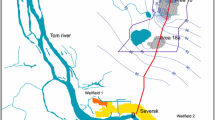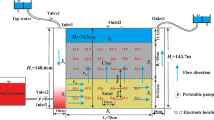Abstract
Most studies that incorporate subsurface heterogeneity in groundwater flow and transport models only analyze and simulate the spatial variability of hydraulic conductivity. Heterogeneity of the other flow and transport parameters are usually neglected. This approach is often justified, but there are, however, cases in which disregarding the heterogeneity of the other flow and transport parameters can be questionable. In low permeability media, for instance, diffusion is often the dominant transport mechanism. It therefore seems logical to incorporate the spatial variability of the diffusion parameters in the transport model. This study therefore analyses and simulates the spatial variability of the effective diffusion coefficient and the diffusion accessible porosity with geostatistical techniques and incorporates their heterogeneity in the transport model of a low permeability formation. The formation studied was Boom clay (Belgium), a candidate host rock for the deep geological disposal of high-level radioactive waste. The calculated output radionuclide fluxes of this model are compared with the fluxes calculated with a homogeneous model and a model with a heterogeneous hydraulic conductivity distribution. This analysis shows that the heterogeneity of the diffusion parameters has a much larger effect on the calculated output radionuclide fluxes than the heterogeneity of hydraulic conductivity in the low permeability medium under study.
Résumé
Analyse stochastique de l’effet de la variation spatiale des paramètres de diffusion sur le transport de radionucléides dans les niveaux argileux de faible perméabilité. La plupart des études qui prennent en compte l’hétérogénéité du sous-sol dans les modèles d’écoulement et de transport de l’eau souterraine analysent et simulent la variation de la conductivité hydraulique. L’hétérogénéité des autres paramètres de l’écoulement et du transport est souvent négligée. Si cette simplification est souvent justifiée, parfois, la non-prise en compte de l’hétérogénéité des autres paramètres de l’écoulement et du transport est discutable. Par exemple, dans les milieux à faible perméabilité, la diffusion est souvent le moyen privilégié de transport. Il paraît par conséquent logique d’incorporer la variabilité de ce paramètre dans le modèle de transport. Cette étude analyse et simule la variation spatiale du coefficient de diffusion et de la porosité disponible pour la diffusion grâce aux techniques géostatistiques. L’hétérogénéité de ces paramètres est prise en compte dans le modèle de transport d’une formation à faible perméabilité. La formation étudiée est celle des argiles de Boom (Belgique), une roche candidate pour l’hébergement à grande profondeur de déchets hautement radioactifs. Les flux sortants de radionucléides nucléides calculés par ce modèle sont comparés aux flux calculés avec un modèle homogène et avec ceux d’un modèle qui intègre une hétérogénéité de la distribution de la conductivité hydraulique. L’analyse montre que dans ce milieu à faible perméabilité, l’hétérogénéité des paramètres de diffusion à des effets bien plus importants sur les flux sortants des radionucléides que l’hétérogénéité de la conductivité hydraulique.
Resumen
La mayoría de los estudios que incorporan la heterogeneidad subsuperficial en los modelos de flujo y transporte de agua subterránea, sólo analizan y simulan la variabilidad espacial de la conductividad hidráulica. La heterogeneidad de los otros parámetros de flujo y transporte es normalmente menospreciada. Este acercamiento es a menudo justificado, pero sin embargo hay casos en los cuales la falta de atención a la heterogeneidad de los otros parámetros de flujo y de transporte puede ser cuestionable. En los medios de permeabilidad baja, por ejemplo, la difusión es a menudo el mecanismo de transporte dominante. Parece lógico por consiguiente incorporar la variabilidad espacial de los parámetros de difusión en el modelo de transporte. Este estudio analiza por consiguiente y simula la variabilidad espacial del coeficiente de difusión eficaz y la porosidad de difusión accesible, usando técnicas geoestadisticas e incorpora su heterogeneidad en el modelo de transporte de una formación de permeabilidad baja. La formación estudiada fue la Arcilla Boom (Bélgica), una roca huésped escogida para la disposición geológica profunda de desechos de alto nivel de radiactividad. Los flujos calculados de salida del isótopo radioactivo de este modelo, se comparan con los flujos calculados con un modelo homogéneo y un modelo con una distribución de conductividad hidráulica heterogénea. Este análisis muestra que la heterogeneidad de los parámetros de difusión, tiene un efecto mucho más grande sobre el flujo calculado de salida del isótopo radioactivo, que la heterogeneidad de la conductividad hidráulica en el medio de permeabilidad baja estudiado.













Similar content being viewed by others
References
Aertsens M, Wemaere I, Wouters L (2004) Spatial variability of transport parameters in the Boom Clay. Appl Clay Sci 26(1–4):37–45
Copty NK, Findikakis AN (2000) Quantitative estimates of the uncertainty in the evaluation of ground water remediation schemes. Ground Water 38(1):29–37
Deutsch CV, Journel AG (1998) GSLIB geostatistical software library and user’s guide. Oxford University Press, New York
Horseman ST, Higgo JJW, Alexander J, Harrington JF (1996) Water, gas and solute movement through argillaceous media. Nuclear Energy Agency, Organisation for Economic Co-operation and Development, Paris
Huysmans M, Dassargues A (2005) Stochastic analysis of the effect of heterogeneity and fractures on radionuclide transport in a low permeability clay layer. Environ Geol 48(7):920–930
Isaaks EH, Srivastava RM (1989) An introduction to applied geostatistics. Oxford University Press, New York
Mallants D, Sillen X, Marivoet J (1999) Geological disposal of conditioned high-level and long-lived radioactive waste: consequence analysis of the disposal of vitrified high-level waste in the case of the normal evolution scenario, ONDRAF/NIRAS report R-3383, ONDRAF/NIRAS, Brussels, Belgium
Mallants D, Marivoet J, Sillen X (2001) Performance assessment of vitrified high-level waste in a clay layer. J Nucl Mater 298(1–2):125–135
Oz B, Deutsch CV, Tran TT, Xie Y (2003) DSSIM-HR: A FORTRAN 90 program for direct sequential simulation with histogram reproduction. Comput Geosci 29(1):39–51
Pardo-Iguzquiza E, Dowd PA (2002) FACTOR2D: a computer program for factorial cokriging. Comput Geosci 28(8):857–875
Pohlmann K, Hassan A, Chapman J (2000) Description of hydrogeologic heterogeneity and evaluation of radionuclide transport at an underground nuclear test. J Contam Hydrol 44(3–4):353–386
Scheibe TD, Chien Y-J, Radtke JS (2001) Use of quantitative models to design microbial transport experiments in a sandy aquifer. Ground Water 39(2):210–222
Therrien R, Sudicky EA (1996) Three-dimensional analysis of variably-saturated flow and solute transport in discretely-fractured porous media. J Contam Hydrol 23(1–2):1–44
Therrien R, Sudicky EA, McLaren RG (2003) FRAC3DVS: An efficient simulator for three-dimensional, saturated-unsaturated groundwater flow and density dependent, chain-decay solute transport in porous, discretely-fractured porous or dual-porosity formations, User’s guide, Groundwater Simul. Group, Waterloo, Ontario, Canada
Wemaere I, Marivoet J (1995) Geological disposal of conditioned high-level and long lived radioactive waste: updated regional hydrogeological model for the Mol site (the north-eastern Belgium model), ONDRAF/NIRAS Report R-3060, ONDRAF/NIRAS, Brussels, Belgium
Wemaere I, Marivoet J, Labat S, Beaufays R, Maes T (2002) Mol-1 borehole (April–May 1997): Core manipulations and determination of hydraulic conductivities in the laboratory, ONDRAF/NIRAS Report R-3590, ONDRAF/NIRAS, Brussels, Belgium
Wouters L, Vandenberghe N (1994) Geologie van de Kempen: een synthese, ONDRAF/NIRAS Report NIROND-94-11, ONDRAF/NIRAS, Brussels, Belgium
Acknowledgements
The authors wish to acknowledge the Fund for Scientific Research-Flanders for providing a Research Assistant scholarship to the first author. We also wish to thank ONDRAF/NIRAS (Belgium agency for radioactive waste and enriched fissile materials) and SCK-CEN (Belgian Nuclear Research Centre) for providing the necessary data for this study. We also thank René Therrien and Rob McLaren for providing FRAC3DVS and for their assistance. We thank the anonymous reviewers for their constructive reviews.
Author information
Authors and Affiliations
Corresponding author
Rights and permissions
About this article
Cite this article
Huysmans, M., Dassargues, A. Stochastic analysis of the effect of spatial variability of diffusion parameters on radionuclide transport in a low permeability clay layer. Hydrogeol J 14, 1094–1106 (2006). https://doi.org/10.1007/s10040-006-0035-2
Received:
Accepted:
Published:
Issue Date:
DOI: https://doi.org/10.1007/s10040-006-0035-2




